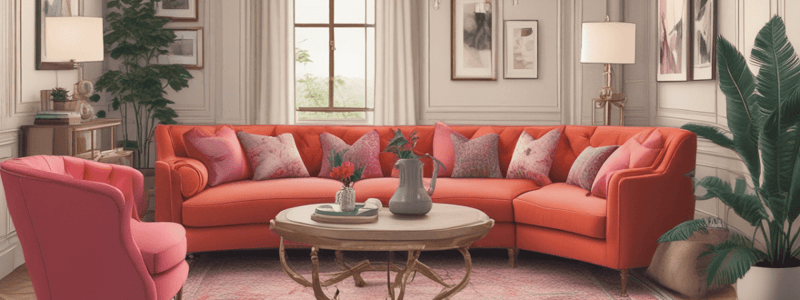Podcast
Questions and Answers
What does the term 'chenille' refer to in the context of fabrics?
What does the term 'chenille' refer to in the context of fabrics?
- A plush and fuzzy yarn originally named after caterpillars (correct)
- A silk fabric with a wavy pattern
- A type of fabric with a glazed surface
- A reversible fabric with elaborate floral designs
Which characteristic distinguishes damask from brocade?
Which characteristic distinguishes damask from brocade?
- Brocade features floral designs while damask does not.
- Brocade is more colorful than damask.
- Damask has an embossed appearance similar to brocade.
- Damask patterns are created through weaving and are reversible. (correct)
What is moire known for in fabric types?
What is moire known for in fabric types?
- Being a sheer cotton or linen fabric.
- Having a padded surface created during weaving.
- Featuring a wavy or watered appearance, particularly in silk. (correct)
- Being a type of strong cotton fabric used for mattresses.
Which fabric is named after a city and is known for elaborate floral designs?
Which fabric is named after a city and is known for elaborate floral designs?
What defines the fabric type known as ticking?
What defines the fabric type known as ticking?
Flashcards are hidden until you start studying
Study Notes
Importance of Accessories in Home Decoration
- Accessories transform houses into warm and inviting homes, reflecting personality and unique style.
- Decorative elements include cushions, throws, lamps, mirrors, plants, flowers, candles, artwork, sculptures, heirlooms, and collectibles.
- Achieving balance in decor involves combining complementary and contrasting items to enhance visual appeal.
- Example: A family room can use palm motif cushions paired with pineapple-patterned cushions for engaging contrast.
Tips for Accessorizing
- Group similar items in sets of three or five for aesthetic coherence.
- Vary heights of items to create depth; taller items should be placed behind shorter ones.
- Keep collections consolidated in specific areas to avoid clutter and showcase their charm.
- Utilize abundant artwork and group pieces together unless a single work dominates the space.
- Mirrors should reflect pleasing views, creating the illusion of more space.
- Incorporate a range of plants to introduce warmth and texture.
- Fresh or silk flowers in ornate vases can add vibrancy and color to rooms.
- Consider wall sconces to enhance artwork or mirrors, elevating overall aesthetics.
- Cushions and throws can introduce texture and color freely for visual interest.
- Use diverse lighting options (floor lamps, table lamps, candles) to create warmth and ambiance.
- In bathrooms, integrate accessories like plants, artwork, and stylish storage to enliven the space.
- Books serve as decorative accents; position them creatively to enhance visual interest without overwhelming the area.
- Avoid over-accessorizing with numerous small items to prevent clutter.
Role of Fabrics in Interior Design
- Fabrics include natural (silk, wool, cotton, linen) and synthetic (polyester, nylon, acrylic) materials.
- Selection for upholstery, wall treatments, bed linens, and accessories should consider design compatibility and durability.
- Understanding fabric properties such as light exposure, moisture, and climate resilience is critical.
- Fabrics infuse spaces with warmth, color, and ambiance; silk drapes add luxury, while wool upholstery provides comfort.
- Opulent fabrics like velvet offer sophistication; casual fabrics like cotton create relaxed vibes.
- Selecting the right weave, weight, and type is crucial for the intended application in interior design.
Types of Fabrics and Their Characteristics
- Batik: Hand-printed fabric dyed by immersion.
- Brocade: Heavy silk with elaborate patterns; embossed appearance.
- Chenille: Plush and fuzzy fabric resembling caterpillars; known for its texture.
- Chintz: Originally any printed cotton; now refers to polished surface fabric.
- Damask: Features reversible floral designs from ancient Damascus; flatter than brocade.
- Jacquard: Woven fabrics with intricate designs created on a jacquard loom.
- Matelassé: Quilted surface fabric; raised pattern made on a loom.
- Moire: Fabric, often silk, with a wavy or watered pattern.
- Ticking: Strong cotton fabric commonly used for mattress covers.
- Toile: Sheer cotton or linen fabric, often used in wallpaper and upholstery.
Conclusion
- Accessorizing is a creative endeavor that personalizes living spaces.
- Thoughtful selection and arrangement of accessories can transform a house into a comfortable, inviting home.
Studying That Suits You
Use AI to generate personalized quizzes and flashcards to suit your learning preferences.




